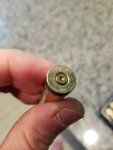I have a relatively mild load that has worked well in my rifle, but yesterday, I took out this exact same load and it started to show some slight pressure signs (faint ejector mark, but no wipe or heavy bolt lift). It also had significant carbon buildup around the case mouth and shoulder, web, and headstamp, none of which I have ever seen before. I don't whether this is a pressure sign, but I suspect it might be. You can see in the third pic the carbon outline of the ejector mark, but most of this is actually just carbon. The last pic (after wiping down with case head with solvent) shows the actual pressure mark is much fainter, but you can just make it out if you look closely.




A little background: the brass is virgin Nosler 7mm rem mag. The load is 61.5 gr of RL-22 under a 162 gr ELD-M, WLRM primer, and set to 0.005" jump. Last week, I took my rifle out for the first time this season, and got less than stellar grouping with a load that I know can hammer if I do my part (I got none of the above pressure signs, btw). I suspected it was either fundamentals, or that my rifle was too dirty (hasn't been cleaned in a little while). So mid-week, I did some light cleaning, which consisted of cleaning out the chamber with a few dry stick patches until they came out clean, and pushing a solvent patch down the bore (using a bore guide), and following up with a few dry patches (I did this latter process twice). No copper solvent.
I also suspect, but don't know, that I might have carbon rings. The reason I suspect this (and I could be wildly wrong) is that when I used a Hornady OAL gauge to set my CBTO for a 0.005" jump, I got what looked like little scrapes on the ogive that looked like the bullet had been pushed into the lands, even though I doubt the light finger force I used on the gauge when pushing the bullet to the lands could have jammed the bullet. I also suspect carbon rings, because this is a mild load that has never shown signs of pressure, and now it suddenly does.
I don't have access to a borescope. If carbon rings are a potential issue here, I found there is frustratingly inconsistent information about (1) whether, (2) when, and (3) how to get rid of them. I do have some KG #2 paste should that be needed, but I've never used it.
So, my questions are:
1. Is the carbon build up in the pics a pressure sign?
2. What could have caused it, given that it normally does not occur in this load?
3. Based on the information I provided above, what are some potential solutions?
4. Should I trash this brass?
A little background: the brass is virgin Nosler 7mm rem mag. The load is 61.5 gr of RL-22 under a 162 gr ELD-M, WLRM primer, and set to 0.005" jump. Last week, I took my rifle out for the first time this season, and got less than stellar grouping with a load that I know can hammer if I do my part (I got none of the above pressure signs, btw). I suspected it was either fundamentals, or that my rifle was too dirty (hasn't been cleaned in a little while). So mid-week, I did some light cleaning, which consisted of cleaning out the chamber with a few dry stick patches until they came out clean, and pushing a solvent patch down the bore (using a bore guide), and following up with a few dry patches (I did this latter process twice). No copper solvent.
I also suspect, but don't know, that I might have carbon rings. The reason I suspect this (and I could be wildly wrong) is that when I used a Hornady OAL gauge to set my CBTO for a 0.005" jump, I got what looked like little scrapes on the ogive that looked like the bullet had been pushed into the lands, even though I doubt the light finger force I used on the gauge when pushing the bullet to the lands could have jammed the bullet. I also suspect carbon rings, because this is a mild load that has never shown signs of pressure, and now it suddenly does.
I don't have access to a borescope. If carbon rings are a potential issue here, I found there is frustratingly inconsistent information about (1) whether, (2) when, and (3) how to get rid of them. I do have some KG #2 paste should that be needed, but I've never used it.
So, my questions are:
1. Is the carbon build up in the pics a pressure sign?
2. What could have caused it, given that it normally does not occur in this load?
3. Based on the information I provided above, what are some potential solutions?
4. Should I trash this brass?
Attachments
Last edited:



